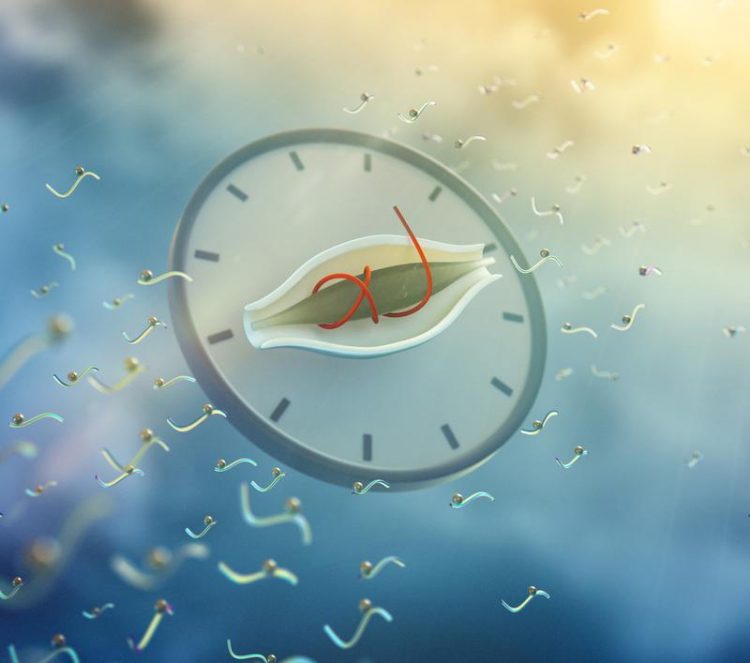The internal clock of cells orchestrates 25 percent of all protein switches

25 percent of the molecular protein switches are active in the rhythm of the internal clock of a cell. This was shown with the help of the mass spectrometry in the livers of mice. Illustration: Max Iglesias © MPI of Biochemistry
Matthias Mann, head of the department “Proteomics and Signal Transduction” at the Max-Planck-Institute of Biochemistry has optimized, together with his research group, the mass spectrometry for use in the clinic over the last few years. This technology enables analysis of proteins both quantitatively and qualitatively in cells and tissue.
Additionally, mass spectrometry also enables researchers to study the phosphorylation of proteins – the binding of a phosphate molecule can change the structure and the molecular characteristics of the protein. The phosphate molecule thereby functions like a protein switch, capable of changing the protein activity and function.
This method was used by the scientists to investigate whether the inner clock, the circadian clock, in cells and organs can drive changes of these phosphate switches. Charo Robles, head of the study explains: “The circadian clock is the internal timer in the cell. The rotation of the earth leads to periodic changes of the environment, associated with the day and night that influences living organisms. The inner clock allows organisms to predict the daily fluctuations in the environment and thus adapt the cellular metabolism and physiology.
In the past, it was already discovered that a large proportion of the transcriptome, a set of the messenger RNA molecules and the manual for the proteins, as well as a proportion of the proteins themselves in cells and tissues undergo circadian cyclic rhythms of abundance. This study examined in the circadian changes of the phosphoproteome, the whole set of phosphorylation binding sites in proteins, in the mouse liver.
“While approximately 10 percent of the messenger RNA and the proteins cycle daily in their abundance, we now show that more than 25 percent of the protein switches, phosphorylation events, change across the day and night to control the function of the proteins in the liver of mice.”, says Robles. “As a simple analogy in our daily lives: in the morning we switch the computer when we arrive at work, and switch it off again in the evening, while at home we might switch on the TV in the evening.”
With the help of mass spectrometry the scientists were able to analyze the complex network of the protein switches. “We do not detect just one switch but rather we can analyze when the different switches are turned on and off in the whole city as analogue of the cell”. The scientists showed that around 2,000 phosphorylation positions change between the day and night. Some switches were newly discovered in this study.
With this knowledge, when specific proteins are activated we could promote so called “Chronotherapy”. Cellular processes as well as whole organ physiology display cycles of activity across the day. This influences the efficacy and the tolerance of medication. “In the future if we know when in an individual patient specific signaling pathways are activated, we could optimize the treatment of diseases, giving the medication at the appropriate time point to increase efficiency and minimize adverse effects.”, says Robles.
Original publication:
M.S. Robles, S.J. Humphrey & M. Mann: “Phosphorylation is a central mechanism for circadian control of metabolism and physiology”. Cell Metabolism, 2016
DOI: 10.1016/j.cmet.2016.10.004
Prof. Dr. Matthias Mann
Proteomics and Signal Transduction
Max Planck Institute of Biochemistry
Am Klopferspitz 18
82152 Martinsried
Germany
E-Mail: mmann@biochem.mpg.de
www.biochem.mpg.de/mann
Dr. Christiane Menzfeld
Public Relations
Max Planck Institute of Biochemistry
Am Klopferspitz 18
82152 Martinsried
Germany
Tel. +49 89 8578-2824
E-Mail: pr@biochem.mpg.de
Weitere Informationen:
http://www.biochem.mpg.de/en – homepage max planck institute of biochemistry
http://www.biochem.mpg.de/en/rd/mann – homepage Matthias Mann
Media Contact
All latest news from the category: Life Sciences and Chemistry
Articles and reports from the Life Sciences and chemistry area deal with applied and basic research into modern biology, chemistry and human medicine.
Valuable information can be found on a range of life sciences fields including bacteriology, biochemistry, bionics, bioinformatics, biophysics, biotechnology, genetics, geobotany, human biology, marine biology, microbiology, molecular biology, cellular biology, zoology, bioinorganic chemistry, microchemistry and environmental chemistry.
Newest articles

Properties of new materials for microchips
… can now be measured well. Reseachers of Delft University of Technology demonstrated measuring performance properties of ultrathin silicon membranes. Making ever smaller and more powerful chips requires new ultrathin…

Floating solar’s potential
… to support sustainable development by addressing climate, water, and energy goals holistically. A new study published this week in Nature Energy raises the potential for floating solar photovoltaics (FPV)…

Skyrmions move at record speeds
… a step towards the computing of the future. An international research team led by scientists from the CNRS1 has discovered that the magnetic nanobubbles2 known as skyrmions can be…





















